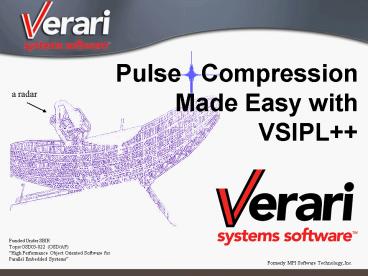Pulse Compression Made Easy with VSIPL - PowerPoint PPT Presentation
1 / 10
Title:
Pulse Compression Made Easy with VSIPL
Description:
Create Vectors. Create Forward FFT object. Create Inverse FFT object. Create 3 temporary vector to hold intermediate frequency domain results. ... – PowerPoint PPT presentation
Number of Views:297
Avg rating:3.0/5.0
Title: Pulse Compression Made Easy with VSIPL
1
Pulse Compression Made Easy with VSIPL
a radar
Funded Under SBIR Topic OSD03-022 (OSD/AF) High
Performance Object Oriented Software for Parallel
Embedded Systems
Formerly MPI Software Technology, Inc.
2
VSIPL and VSIPL Reference Implementations
The VSIPL Reference Implementation
The VSIPL Reference Implementation Builds upon
the VSIPL Reference Implementation
3
VSI/Pro Product and the VSI/Pro Prototype
The VSI/Pro Prototype Builds upon the VSI/Pro
Product
Structure of VSI/Pro
4
Layered Approachversus a Pure Implementation
- What are the benefits of a Pure VSI/Pro
Product. - Having both API bindings available is a hidden
benefit to programs that want to migrate their
systems from VSIPL to VSIPL in phases.
5
Performance Comparison for1024 Point Complex FFT
- Did not experience any significant overhead from
layering the VSIPL API on top of the VSI/Pro
API (See rightmost column).
6
Case Study Pulse Compression
Pulse Compression works by distributing the
energy in the outgoing Radar pulse over a larger
span of time with one of a select number of
waveform pulses that are generally known as chirp
waveforms. This kind of filtering not only
improves the accuracy of the measurements, but
also rejects most kinds of ambient noise. The net
effect is an improvement in resolution and
decreased demand for peak power requirement in
the signal generation equipment. A typical pulse
consists of a short burst of frequency like the
one shown here.
The digital signal processing functions that are
associated with pulse compression applications
typically use a complex FFT, a complex reference
multiply, followed by an inverse complex FFT.
Pulse compression, and FFT processing in general
comprise a major portion of the processing load
in state of the art radar systems.
7
Pulse Compression The VSIPL way
The pseudocode Create Vectors Create Forward FFT
object Create Inverse FFT object Create 3
temporary vector to hold intermediate frequency
domain results. Convert reference signal vector
to the frequency domain Forward FFT( Ref Signal
Vec, Temp Vec1 ) Convert Input signal to the
frequency domain Forward FFT( Input Signal Vec,
Temp Vec2 ) Multiply vectors in the frequency
domain Vector Multiply( Temp Vec1, Temp Vec2,
Temp Vec3 ) Obtain the inverse FFT Inverse FFT(
Temp Vec3, Answer Vec )
8
Pulse Compression The VSIPL way
The pseudocode Create Vectors Create Forward FFT
object Create Inverse FFT object Answer Vec
INV_FFT( FFT(Input Vec)FFT(Reference Signal
Vec))
Reference Signal
Noisy Return
9
Integrating Expression Manipulation into VSIPL
- Expression object strategies address the
important problem oftemporary copy proliferation
that occurs as a result of operatoroverloading
in C. - Existing technologies that were studied -
- PETE (Portable Expression Template Engine)
- Developed at the Advanced Computing Laboratory
atthe Los Alamos National Laboratory - BLITZ
- The goal of Blitz is to provide a similar level
of performanceon par with Fortran 77/90 - FACT! (Functional Additions to C through
Templates and Classes ) - A library that provides expression manipulation
plus other functional - programming language features not normally
accessible in C.
10
Observations from using VSIPL
- Benefits
- Concise code
- Readable
- Natural looking expressions
- Hazards
- Complex looking data types, may behelped in
practice by typedefs - General C concerns (e.g., possible toabuse
the language)































